Enjambment, Existence
Studies on film poetry and videopoetry
One of the defining characteristics of avant-garde cinema is the resistance to mainstream form and elements to present radical narratives and ideals. In experimental film, the medium of film is challenged and exists in many other spheres. The artist treats the screen as a canvas and manipulates it for its graphical characteristics, as Maya Deren describes in Cinematography: The Creative Use of Reality. The poet plays with filmic conventions, now with much more dimensions at hand: the running of diegetic sound against edited soundtrack, the sequencing and depth of each frame. It poses a near impossible challenge to draw direct boundaries between entirely different art forms; moreso with the relatively new art form of cinema against the millennia of poetry.
The evolution of cinema can never do without ode to the art forms that had preceded it. While we’ve witnessed the past century’s cinematic evolution that had taken its own ideals from the birth of the motion picture, we can also examine experimental and avant-garde cinema that pay closer respect to the medium’s intertwine with language and text. In the 1984 essay The Poetry Film by William Wees, the writer articulates a movement and synthesis of poetry and film that “generates associations, connotations, and metaphors neither the verbal nor the visual text would produce on its own.” Coining the genre “poetry-film” and establishing its interdependence, we see a relationship that uniquely explores the unbounded potential in stretching meaning behind both words and images through a new set of filmic and poetic constraints. Where film artists explore the specificities of their own language, film-poems must contend with their nature of e
In as early as 1978, Tom Konyves used the term videopoetry to indicate a fusion of text, image, and sound distanced from film poetry. Decades later in 2011, he published a manifesto describing the form further as a genre of poetry (rather than a subgenre of film), emphasizing the usage of the screen to work towards the realization of a poetic experience. He also brings up the question raised by bringing poetry to the screen: there exists a position demystifying the linguistic poem with complementary visuals, and the position of videopoetry augmenting the suggestive power of poetry through unexpected juxtapositions and abstractions.
Poetry-Film and Videopoetry in Generic Analysis
In the existence of poetry-film and videopoetry as genres, like in the description of any other genre, we must also pay keen attention to how filmmakers position or distance themselves in relation to the work of poetry. A respect to language, text, and type does not immediately embrace the emphasis on experience that poetry-film may bear, or the distinction that videopoetry draws with text as a counterpoint to image and sound. As Deleyto explains that film, even experimental, can never escape a realm of generic conventions or formulae, film-poems themselves must be inseparable from some characteristic of film or poetry. This may manifest itself in the heavy use of graphic text as an element in the film that becomes a visual film of text and audio, or even a literal filming of text without any visual movement. While these boundaries can express themselves in several ways, never fixed, it’s valuable to analyze film-poems on the basis of the conventions, structures, and patterns they borrow from film and poetry independently to better understand the workings of how they’re mixed just as generic analysis functions.
Considering a work of film as “poetic” does not automatically equate it to videopoetry; as the work of filmmakers in crafting structure and form are challenged against conventions of cinema and poetry. Here, I delve into a distinction between “poetic cinema/film poetry” and “videopoetry” through some studies of short, avant-garde films and how they maneuver each subgenre of film and poetry––predominantly through structure and related movements.
Poetics in Film, as Film Poetry
Stan Brakhage's
Mothlight (1963)
Perhaps the most prominent example of filmmaker-as-poet is Brakhage, a leading figure in avant-garde cinema whose experimental works were more like visual poetry than any other. As a director, Brakhage was heavily influenced by poetry and associated with poets such as Robert Duncan; when asked to describe his works, he opted for the term “poetic film” where rhythm, color, and form were undoubtedly imbued unto the filmic experience, more than literature. Here, these crafts do not just complement the film, but are ingrained in its nature and the audience’s consumption of it. Instead of traditional narrative elements, Brakhage crafted a body of work that maximized the sensory experience of a film: he played with the screen through light, raw objects, and demanded perception beyond any traditionally enclosed reality. In these “adventures in perception”, his silent films played with layers of depth as he manipulated film stock, challenged the subjective viewer’s cognitive load, and played with overwhelmingly intense cinematographic exercises. For instance, Brakhage’s choice of silent film demands the viewer to pay full attention to the act of the film playing itself: a reel rolling, the body’s internal sounds, the flickering of a light.
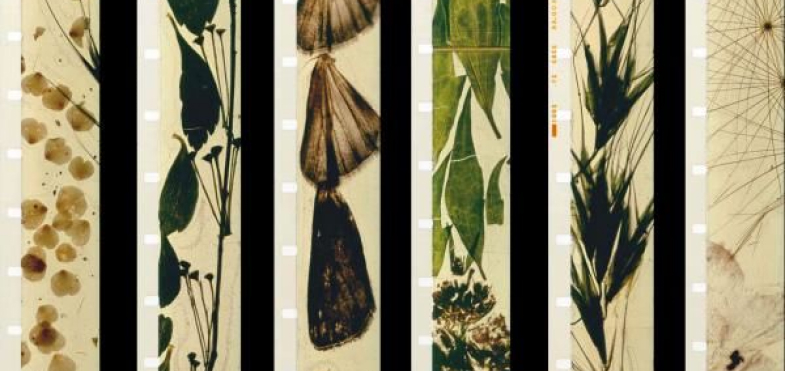
Mothlight is a congruent example of film poetry where existence and expression is invoked to its highest form, with a complete absence of any direct text. In a four-minute sequence of pressed, translucent moth wings and flora between film strips, a sequence that invokes themes of light and death through several metalayers plays out. The medium itself employs a dead object, forced to shine through burning, translucent light on screen when played through film where the play of each sequence is rebirth and the end another infinite death; the sequence itself is jagged, frantic, as a moth drawn to brightness that then spells its end, amongst many others. The elements of poetry are clearly present: the image provoked by Brakhage innate in the film form and deepened by the film form’s layers, the rhythm portrayed through this image in its franticness and carefully curated by Brakhage in the initial acts of collage and assemblage, to the careful attention of structure––where the film is even regarded as a “three-act”.
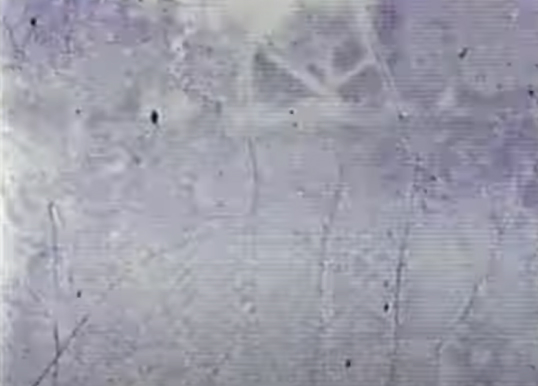

Brakhage’s work is poetic, linked to visual poetry and concrete poetry where structure and arrangement gives the work needed depth, augmenting its existence most. John Sharkey, a curator of the genre, notes this establishment where the poet is aware of the “graphic space as a structural agent”. Brakhage plays with dimension and space on so many literal layers that Mothlight would lose depth if for example, it were instead crafted digitally; this essential element of handcrafted collage is inseparable from the piece and would change its meaning entirely. Poetics is then exemplified in visual form, linked more to graphical structure than any verbal art; comparable to patterned and shaped poems where words are arranged to depict a larger subject.
Mothlight exemplifies the structuralism movement, non-illusionist and direct in device.
We can also link Brakhage’s work to the movement of structural film in its utilization of fixed framing and flickering, emphasized by the film strip’s intermittence. Instead of filmmaking that focused on mimicking and representing reality in two-dimensional spaces, audience participation is put on a higher pedestal that demands awareness of the medium’s limitations and craft itself. Instead of focusing solely on a reality depicted on-screen, the rolling film camera, the space of the room being participated in, and the intensity of light affirm the work. Another core part of structural film is the repetitive nature. As opposed to angles, scenes, transitions, and other variable editing choices that constantly reposition the viewer, the strength of form (here, the rolling film camera) is substantiated through repetition. Traditional convention of a narrative played out in the film’s reality is substituted for a narrative that embalms the viewer and the medium in the process. Further, the absence of traditional photography, sound, and text highlight Brakhage’s work as a poetic film form that does not necessitate the existence of the photograph or motion-picture.
Mothlight’s poetics do rely on the existence of cellulose acetate film. Without the collage on film strips, the integrity of the narrative Brakhage had established without traditional devices would be interrupted. Luis Recoder’s The Death of Structural Film recognizes this phenomena that we see in present-day cinema: historically, Mothlight could stand as cinema respecting the film form before the death of film, but it remains far from the death of cinema in its absolution. Instead, the poetics in Brakhage’s work established by structuralism and the visual arts recognize “a death of cinema as a cinema based on the material make-up of cellulose acetate film”. In later consumption we also encounter a paradoxical reliance on photography, what the film originally rejected, as we relive the work in film prints, digital reproduction, and YouTube videos –– relying on descriptions of how the film was assembled. Recorder continues that this exceedingly materialist view on film might be stretched to projected light, the ultimate base and support of the filmstrip’s transparency. It acts as the last film. Yet, it is poetic all the same.
Bruce Baillie's
All My Life (1966)
Baillie’s All My Life is a near-three minute single take in Mendocino, California of a camera panning leftward, giving us an pastoral, autumnal view of nature and a withering fence soundtracked to Ella Fitzgerald’s song of the same title before ending with a slow tilt up towards electrical lines and the pristinely blue sky. The film consists of a continuous moving shot, breathing life into an inanimate fence. With a sparkling use of color, the film blooms with more life as red and green hues overtake the expanse of yellow, before retreating to the plain blue sky. The film has no narrative at all, no text, instead relying on the visual poetics resting on a fence and the lush imagery after it. It’s intensely graphical, filled with long shots and intensely real. With his works described like “poetic documentary”, there is a first-person nature to his cinematic that invites the spectator to live and immerse in the experience fully. This play with duration is reminiscent of the editing techniques utilized in the French poetic realism movement, literally fixating on long, uninterrupted cuts rather than quickened montage.
Baillie's work with the camera is deft and precise, making his sequences seem effortless, like home.
Baillie plays with film like documentary, working as if to seize a moment in time. Like Brakhage before him, Baillie’s lyricism is subtle, endearing, and homely––and crafted his work in a way that seemed effortless. Instead of intricate editing that infused surrealism into his work like Maya Deren’s films or the exploitation of film as a medium itself as done by Stanley Brakhage, Baillie was armed with a video camera, tripod, time, the perfect space, and most obscured––a keen vision. This simplicity turned the film into a radical vehicle in its own right. The poetry takes its place instead in a careful flow of images and chosen subject matter, a non-narrative take that instead captures feeling and expression putting its weight on the viewer’s subjectivity.
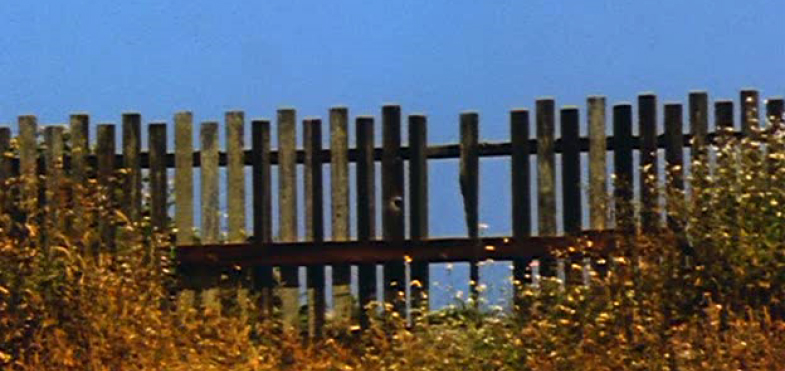
What may be the most obvious filmic choice is the precision of the camera movements employed by Baillie: the tracking shot depicted relies on an optical illusion to present the infinite straightness of the withering fence, creating illusory continuity and equidistance in the spectator’s eyes. Keeping with this careful method of eye-tracking within a seemingly simple, coherent scene exploits our optical systems even further; the expression and moment kept remains cohesive. Aside from the visual play, the auditory layer of the clip keeps us fixated on a moment rather than any specificity in the shot: Ella Fitzgerald’s voice elevates the work and brings it deeper lyricism against the first-person camera, the act of looking is timed with the song as the vocals fade––followed by the instrumentals. Together, simplicity becomes profound and the lyrical irresistible. The undertone of a decaying fence comes alive.
Text in Film, as Videopoetry
Sky Hopinka's
Jáaji Approx. (2015)
Directly exploring relationships and space through audio recordings, text and image, weaving several narratives at once in a complex collage. In its 7-minute runtime, text in the Hočak language overlay English language conversations between Hopinka and his father, overlaid over recordings of and from his father over a decade. It is only when an olden English song is hum in one of the recordings that the text shifts back into the Latin alphabet, italicized; as outward spectators to this father-and-son relationship, the film suddenly shifts and gives attention to us, the foreign viewer. It’s jarring, staticky, and overlaid on mostly black footage before a vehicle lights up the frame and speeds by, cutting off to a new scene. Other times, Hopinka showcases text written out in the International Phonetic Alphabet, reducing distance content-wise but alienating every potential viewer further as it speeds by, turning from a role of utility and function to mere linguistic nods. It is only when every element of the film converges: Hopinka’s narration turns into singing with his father, the audio of the background quiets and brings focus into a merged chorus, and video recordings become mirrored and superimposed on one another that we are given a chance to look over the window of the world Hopinka sees.
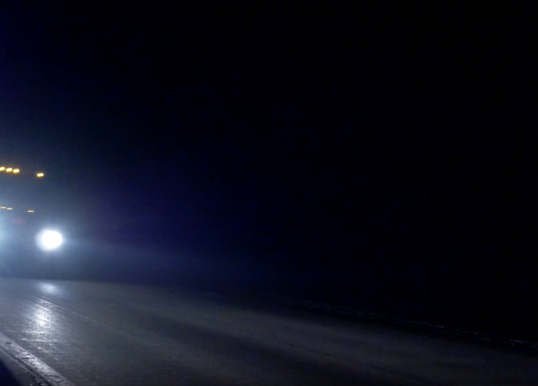
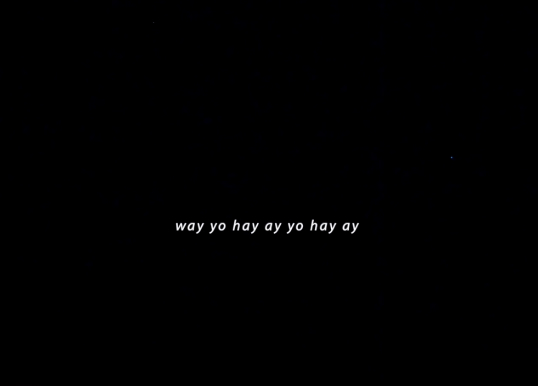
Like Brakhage before him, Hopinka plays with perception, this time manipulated in editing and post-production. Brightness and contrast is altered throughout the film in respect to the text highlighted, and suddenly, saturation goes up towards the end. In reflection of his work, Hopinka views this graphical play as a chance to imbue surrealism to his narrative; not just pitious view at a distant relationship or the act of ethnography, but a relationship given life. These blown-out shots resist the romanticization of Native American experiences, one of the prominent tools employed in the film. Along with treatment of saturation in post-production, the work cannot exist without its treatment of text and language. On paper, it is a series of transcriptions and loose translations, almost amateurish in Hopinka’s play, taking jabs at ethnography. Interlaced with combinations of video and audio, it becomes a deeper meditation that represents both time, space, and achieves the filmmaker’s goal of approximating distance between a familial relationship through past recordings.

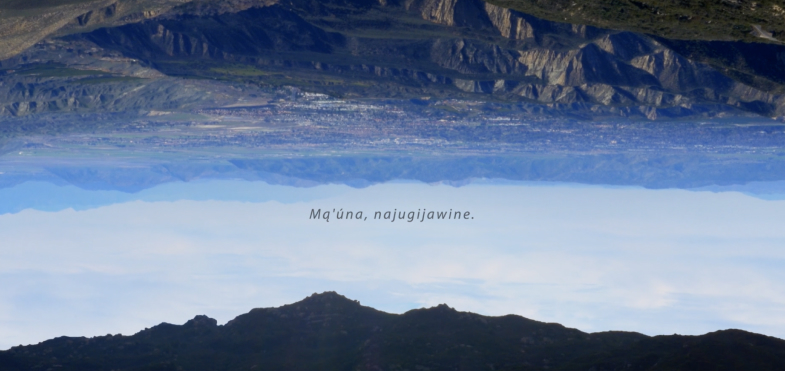
Hopinka and Jáaji sing, over the other, in harmony.
Hopinka achieves this successfully through the development of a clear literary and aesthetic ideology in the film. Most immediately, this is put forth by nature of Hopinka feeling distanced from his father’s Ho-Chunk Nation roots and his own position as a spectator to the indigenous identity put forth by the film and the dislocation he feels. As secondary viewer, we witness this twofold as the Ho-Chunk nation’s language of Winnebago (of which there are only 250 remaining native speakers today) is continuously imposed on the screen. Its orthography is left for the majority of viewers to experience as an aesthetic treatment unable to be meditated on as deeply as the spaces or narrative voiceover. Before each sequence, like an ethnographer, Hopinka announces the metadata of each recording: a time, and with who. Both the traditional filmic reality shown through recordings stresses the distance felt between son and father (across mountains, roads, and gas stations), complemented by the continuous (and titular) use of approximate translations whenever his father speaks to a language Hopinka does not feel as close towards. These layers of discord are present throughout almost all sequences of the film until the aforementioned overlay of Hopinka’s voice with his own father in one, where breathing room is given and the film is firstly free of disharmony against mirrored and parallel shots edited over one another––before fading into black once again. It is the closest instance of nearness that the film gives us.
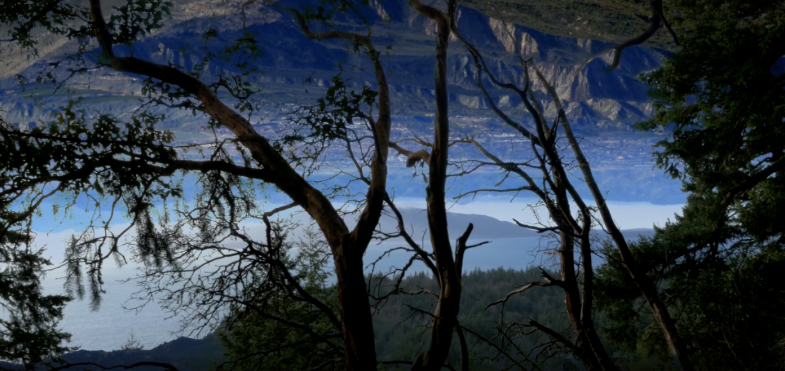
As the harmony ends, a composite shot of nature overlays an upturned mountain, cutting directly into this scene.
The use of image is also unique and illustrative of a new narrative in their own right. We’re not given clips of the words being spoken, nor sequences that are direct representations of the short discussions and songs shared in the piece’s audio. Following in videopoetry’s illustrative nature, we instead see a poetic juxtaposition of image against audio presenting distant realities that the viewer is left to mend in their own perception and reading of the film, creating a new iteration of associations far from the filmmaker’s knowledge. The multiplicity in the experience demands leaps from the viewer; the spectator is unable to be passive as their imagination is commanded to be exercised.
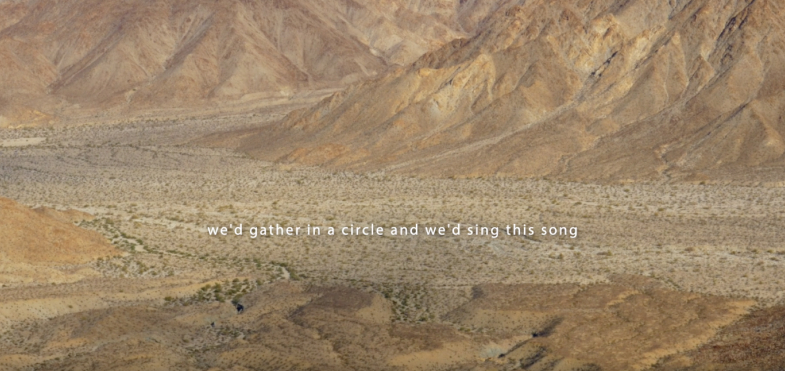
With the elements of distance, direction, and time traversed through text, sound (even in song), and image, we experience a new reality despite poetic’s opposition to it: the layers of association drawn between translations, recordings, and the host of repurposed and reclaimed ethnographic techniques Hopinka uses present endless modes of spectatorship in the experience that traditional film and editing techniques would not be able to rival. What does the film mean to a non-Native audience? To an audience that doesn’t speak English at all, removing the jarring breakdown? To someone who has experienced the same views and is also given the metadata of space and distance in addition to time? Both the symmetrical and asymmetrical in Jáaji Approx bring us to experience a harmony between narrative and non-narrative moments. Finally, we’re offered resolution at the final scene as we finally get a glimpse of Jáaji’s silhouette in the car, windows to the sky all tinted in different hues.
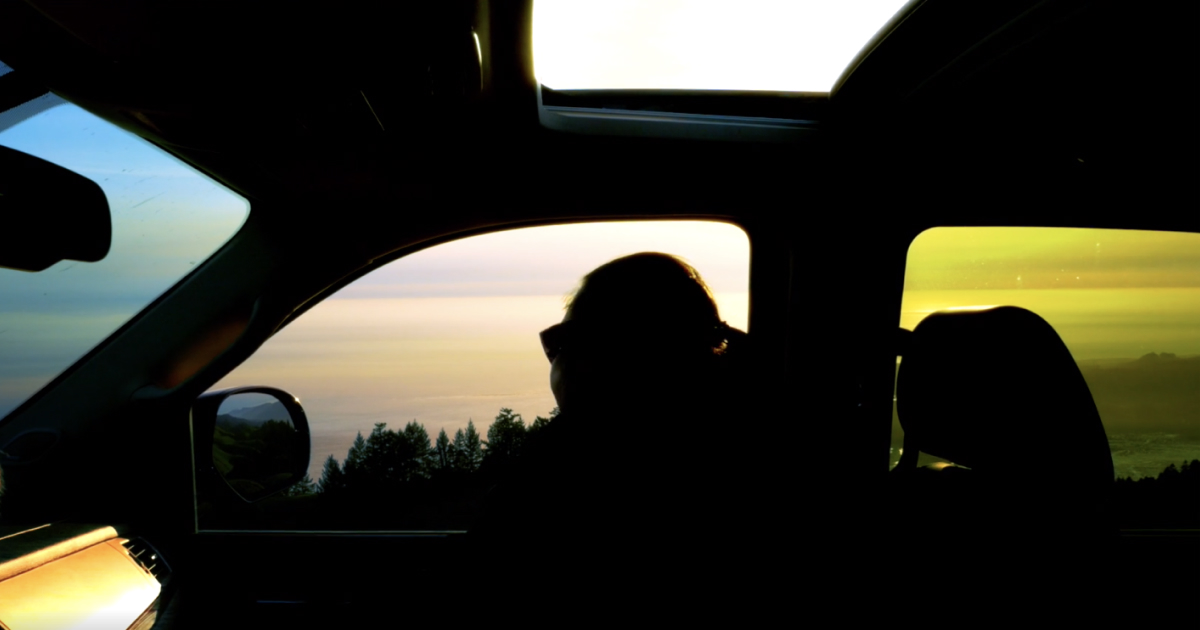
The use of poetry whether auditory or textual, materialized and overlaid on shots or merely suggested by music is exemplified in many films in the experimental and avant-garde movement. When filmmakers embrace this form of expression and lyricism in relation to film or poetry, we see a unique unification of text, image, and sound that creates layers of subjective realities that would otherwise be absent in traditional cinema.
Both film and poetry are highly temporal and bow to structure; a keen respect to form is required to achieve a successful integration of the two. These studies show different means of embracing this treatment: here, the transformation of film into film poetry or videopoetry and the resulting new, intertwined expression presupposes a transformation of the poem itself (the physicality of rebirth in Mothlight, song to imagine a continuous moment in All My Life, transcription and ethnography in Jáaji Approx). With this task of juxtaposition at place, the most challenging task of the filmmaker is to tackle simultaneity where not only one dimension of reality is crafted (as in mainstream cinema). Distant text, image, and audio to craft open narratives and realities becomes the truest challenge: the balancing act becomes the demonstration of control over narrative impulse. the poetic experience masters spatial and temporal relationships between the three elements, and the film plays prosaic.
References
Abrams, M. (2017, September 29). In search of lost words: The work of sky Hopinka. Los Angeles Review of Books. https://lareviewofbooks.org/article/in-search-of-lost-words-the-work-of-sky-hopinka/
Aristotle. (1961). Aristotle's poetics. Macmillan.
Bonta, D., & Craven, M. (2019, August 31). Poetry and film: An essay in two voices. Moving Poems Magazine. https://discussion.movingpoems.com/2019/08/an-essay-in-two-voices-on-poetry-and-film/
Bordwell, D. (n.d.). Poetics of cinema. Observations on film art. https://www.davidbordwell.net/blog/category/poetics-of-cinema/
Bordwell, D., & Thompson, K. (1997). Film Art: An Introduction. https://sites.fas.harvard.edu/~fc76/Handouts/A__Principles_of_Form.html
Burch, N. (1979). Film's Institutional Mode of Representation and the Soviet Response. Essays in Honor of Jay Leyde, 11(1), 77-96. https://www.jstor.org/stable/778236
Cay, E. (2017, August 12). Poetryfilms: When poetry and film have a flirt. Per Ars Poetica Ad Cor Vitae. https://www.eleni-cay.com/blogs/2017/8/12/poetryfilms-when-poetry-and-film-have-a-flirt
Deleyto, C. (2012). Film Genres at the Crossroads: What Genres and Films Do to Each Other. In Film Genre Reader 4 (pp. 218-236). Texas University Press.
Deren, M. (1960). Cinematography: The Creative Use of Reality. The Visual Arts Today, 89(1), 150-167. https://www.jstor.org/stable/20026556
English, L. (2013, September 4). A brief introduction to film poetry. The Writing Platform. https://thewritingplatform.com/2013/09/a-brief-introduction-to-film-poetry/
Ganguly, S. (2017, September 27). Adventures in perception: Stan Brakhage in his own words. The Criterion Collection. https://www.criterion.com/current/posts/4956-adventures-in-perception-stan-brakhage-in-his-own-words
Hudson, D. (2020, April 14). The poetic vision of Bruce Baillie. The Criterion Collection. https://www.criterion.com/current/posts/6906-the-poetic-vision-of-bruce-baillie
James, D. (1982). The Film-Maker as Romantic Poet: Brakhage and Olson. Film Quarterly, 35(3), 35-43. https://www.jstor.org/stable/1211925?seq=1
Konyves, T. (2011). Videopoetry: A Manifesto.
Konyves, T. (2013, February 1). Visual Text in Videopoetry: Two Case Studies. Canadian Review of LIterature in Performance. https://litlive.ca/tom-konyves-visual-text
Leropoulos, F. (2017, October 4). Film poetry: A historical analysis. 5 metros de poemas. https://5metrosdepoemas.com/index.php/noticias/22-mapamundi/634-film-poetry-a-historical-analysis
Recoder, L. (2007). The Death of Structural Film. Deaths of Cinema, 26-30. https://cinema.usc.edu/assets/053/10899.pdf
Renaud, N. (2001, September). Stan Brakhage in Montreal. Offscreen. https://offscreen.com/view/brakhage4
Seeloff, D. (2016, November 15). Film poems, experimental films, and the avant-garde: Sitney’s visionary film as told by a non-film person. Ohio State University. https://u.osu.edu/english6778autumn2016/2016/11/15/film-poems-experimental-films-and-the-avant-garde-sitneys-visionary-film-as-told-by-a-non-film-person/
Sharkey, J. J. (1971). Mindplay: An anthology of British concrete poetry.
Sitney, P. A. (2002). Visionary film: The American avant-garde, 1943-2000. Oxford University Press, USA.
Staff, H. (2011, March 11). The complicated relationship of poetry, film and poetry-film. Poetry Foundation. https://www.poetryfoundation.org/harriet/2011/03/the-complicated-relationship-of-poetry-film-and-poetry-film
Study Collection. (n.d.). Poetry-Film & The Film Poem: Some Clarifications. British Artists' Film and Video Study Collection – UAL. https://www.studycollection.co.uk/poetry.html
Ways of Seeing. (2002, December 11). Structural Films: Meditation through Simple Forms. https://www.waysofseeing.org/struct.html